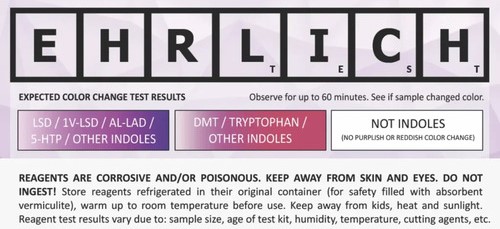Testing
your Molecules

Testing psychedelics like LSD and psilocybin mushrooms is an essential step for harm reduction, especially as the potency and purity of these substances can vary significantly. Testing helps ensure you’re taking a genuine substance, free from potentially harmful adulterants.
The biggest concern with LSD is that it may be substituted with other dangerous substances that mimic its effects but can have vastly different safety profiles, like 25I-NBOMe or other NBOMe compounds, which are much more toxic. Mushrooms tend to be harder to fake, but dried specimens can be hard to identify.
1. Ehrlich Reagent Test
Purpose: To verify if the substance is an indole derivative, which includes LSD and Psilocybin.
How to Use: Place a drop of the Ehrlich reagent on a small piece of the blotter paper or mushroom sample. If it turns purple, it’s an indication of LSD, Psilocybin or another indole compound.
Limitations: This test only confirms that an indole compound is present; it doesn’t verify if it’s LSD specifically.
2. Marquis Reagent Test
Purpose: Helps differentiate LSD from dangerous NBOMe compounds.
How to Use: Place a drop on a sample; if it remains clear, that’s a good sign, as LSD typically doesn’t react strongly. If the reagent turns yellow or has a color reaction, it may indicate the presence of adulterants.
Limitations: Marquis alone isn’t definitive for identifying LSD but can help screen out certain unwanted substances.